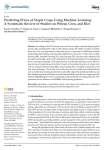Theofilou A., Nastis S.A., Michailidis A., Bournaris T., Mattas K. (2025). Predicting prices of staple crops using machine learning: a systematic review of studies on wheat, corn, and rice. Sustainability, 02/06/2025, vol. 17, n. 12, p. 5456.
http://doi.org/10.3390/su17125456
http://doi.org/10.3390/su17125456
| Titre : | Predicting prices of staple crops using machine learning: a systematic review of studies on wheat, corn, and rice (2025) |
| Auteurs : | A. Theofilou ; S.A. Nastis ; A. Michailidis ; T. Bournaris ; K. Mattas |
| Type de document : | Article |
| Dans : | Sustainability (vol. 17, n. 12, June 2025) |
| Article en page(s) : | p. 5456 |
| Langues : | Anglais |
| Langues du résumé : | Anglais |
| Catégories : |
Catégories principales 11 - COMMERCE ; 11.1 - Commerce (général ou théorique)Thésaurus IAMM MARCHE DES PRODUITS DE BASE ; PRIX AGRICOLE ; ECONOMIE AGRICOLE ; BLE ; MAIS ; RIZ ; PREVISION |
| Résumé : | According to the FAO, wheat, corn, and rice are staple crops that support global food security, providing 50% of the world's dietary energy. The ability to predict accurately these key food crop agricultural commodity prices is important in stabilizing markets, supporting policymaking, and informing stakeholders' decisions. To this aim, machine learning (ML), ensemble learning (EL), deep learning (DL), and time series methods (TS) have been increasingly used for forecasting due to the rapid development of computational power and data availability. This study presents a systematic literature review (SLR) of peer-reviewed original research articles focused on forecasting the prices of wheat, corn, and rice using machine learning (ML), deep learning (DL), ensemble learning (EL), and time series techniques. The results of the study help uncover suitable forecasting methods, such as hybrid deep learning models that consistently outperform traditional methods, and they identify important limitations in model interpretability and the use of region-specific datasets, highlighting the need for explainable and generalizable forecasting solutions. This systematic review adheres to the PRISMA 2020 reporting guidelines. |
| Cote : | En ligne |
| URL / DOI : | http://doi.org/10.3390/su17125456 |







